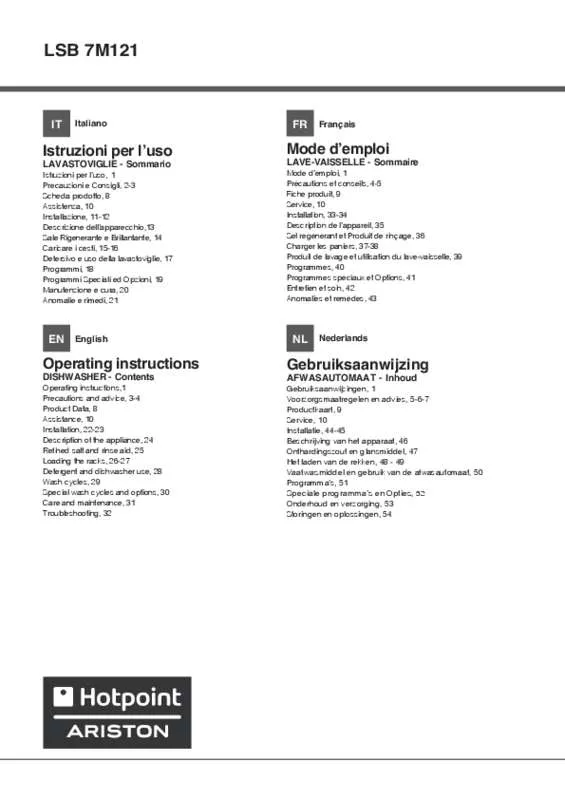Detailed instructions for use are in the User's Guide.
[. . . ] LSB 7M121
IT
Italiano
FR
Français
Istruzioni per l’uso
LAVASTOVIGLIE - Sommario
Istruzioni per l’uso, 1 Precauzioni e Consigli, 2-3 Scheda prodotto, 8 Assistenza, 10 Installazione, 11-12 Descrizione dell’apparecchio, 13 Sale Rigenerante e Brillantante, 14 Caricare i cesti, 15-16 Detersivo e uso della lavastoviglie, 17 Programmi, 18 Programmi Speciali ed Opzioni, 19 Manutenzione e cura, 20 Anomalie e rimedi, 21
Mode d’emploi
LAVE-VAISSELLE - Sommaire
Mode d’emploi, 1 Précautions et conseils, 4-5 Fiche produit, 9 Service, 10 Installation, 33-34 Description de l’appareil, 35 Sel régénérant et Produit de rinçage, 36 Charger les paniers, 37-38 Produit de lavage et utilisation du lave-vaisselle, 39 Programmes, 40 Programmes spéciaux et Options, 41 Entretien et soin, 42 Anomalies et remèdes, 43
EN
English
NL
Nederlands
Operating instructions
DISHWASHER - Contents
Operating instructions, 1 Precautions and advice, 3-4 Product Data, 8 Assistance, 10 Installation, 22-23 Description of the appliance, 24 Refined salt and rinse aid, 25 Loading the racks, 26-27 Detergent and dishwasher use, 28 Wash cycles, 29 Special wash cycles and options, 30 Care and maintenance, 31 Troubleshooting, 32
Gebruiksaanwijzing
AFWASAUTOMAAT - Inhoud
Gebruiksaanwijzingen, 1 Voorzorgsmaatregelen en advies, 5-6-7 Productkaart, 9 Service, 10 Installatie, 44-45 Beschrijving van het apparaat, 46 Onthardingszout en glansmiddel, 47 Het laden van de rekken, 48 - 49 Vaatwasmiddel en gebruik van de afwasautomaat, 50 Programma’s, 51 Speciale programma’s en Opties, 52 Onderhoud en verzorging, 53 Storingen en oplossingen, 54
IT
Precauzioni e consigli
L’apparecchio è stato progettato e costruito in conformità alle norme internazionali di sicurezza. If it was damaged, contact the retailer and do not proceed any further with the installation process. EN
Precautions and advice
This appliance was designed and manufactured in compliance with international safety standards. The following information has been provided for safety reasons and should be read carefully. [. . . ] Upper rack
Load this rack with delicate and lightweight crockery such as glasses, cups, saucers and shallow salad bowls. Very soiled dishes and pans should be placed in the lower rack because in this sector the water sprays are stronger and allow a higher washing performance. Several dishwasher models are fitted with tip-up sectors*. They can be used in a vertical position when arranging tea/ dessert saucers or in a lower position to load bowls and food containers. 26
Tip-up compartments with adjustable position*
The side tip-up compartments can be positioned at three different heights to optimize the arrangement of crockery inside the rack. Wine glasses can be placed safely in the tip-up compartments by inserting the stem of each glass into the corresponding slots. For optimum drying results incline the tipup compartments more. To change the inclination, pull up the tip-up compartment, slide it slightly and position it as you wish. The upper rack can be adjusted for height based on requirements: high position to place bulky crockery in the lower rack and low position to make the most of the tip-up compartments/sectors by creating more space upwards. EN
Adjusting the height of the upper rack
In order to make it easier to arrange the crockery, the upper rack may be moved to a higher or lower position. The height of the upper rack should be adjusted WHEN THE RACK IS EMPTY. NEVER raise or lower the rack on one side only. Cutlery tray*
Some dishwasher models are fitted with a sliding tray which can be used to hold serving utensils or small cups. For optimum washing performance avoid positioning bulky crockery directly below the tray. The cutlery tray can be removed (see Figure). If the rack is equipped with a Lift-Up device* (see figure), lift it up by holding its sides. To restore the lower position, press the levers (A) at the sides of the rack and follow the rack down. Parts in synthetic material which do not withstand high temperatures. The colours of glass decorations and aluminium/silver pieces can change and fade during the washing process. Crystal objects) can become opaque after a number of wash cycles too. Tips:
• Only use glasses and porcelain guaranteed by the manufacturer as dishwasher safe. • Use a delicate detergent suitable for crockery. [. . . ] Water hardness adjustment is not suitable: increase the relevant values. ) • The salt and rinse-aid dispenser cap has not been closed properly. The rinse aid has been used up or the dosage is too low. • The rinse aid dosage is too high. [. . . ]


